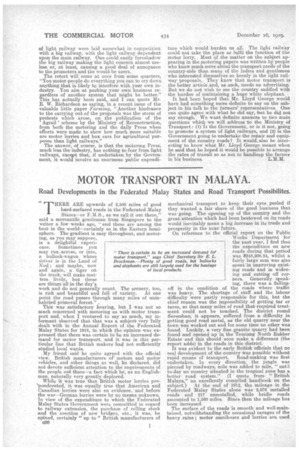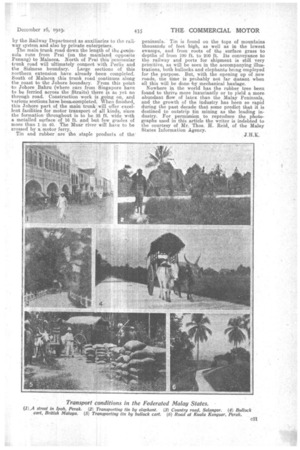MOTOR TRANSPORT IN MALAYA.
Page 16

Page 17

If you've noticed an error in this article please click here to report it so we can fix it.
Road Developments in the Federated Malay States and Road Transport Possibilites.
Fr HERE ARE upwards of 2,500 miles of good
hard-surfaced roads in the Federated Malay
States—or E.M.S., as we call it out there," said a mercantile gentleman from Singapore to the writer a few weeks ago, "and the are among the best in the world—certainly so in the Eastern hemisphere. The gradient is easy throughout, and motoring, as you may suppose, is a delightful experience. Sometimes you may run. across, or into, a bullock-wagon whose driver. is in the Band of Rod; and maybe, now and again, a tiger on the track, will make matters lively, but these
are things all in the day's , work and do not generally count. The scenery, too, is rich and beautiful and full of variety. At one point the road passes through many miles of uninhabited primeval forest." ,
This wars satisfactory hearing, but I was not so much concerned with motoring as with motor transport and, when I ventured to say as much, my informant observed that that was a subject very fully dealt with in the Annual Report of the Federated Malay States for 1918, in which the opinion was expressed that there was certain to be an increased de-, mand for motor transport, and it was in this particular line that British makers had not sufficiently studied local wants.
My friend said he quite agreed with the official view. British manufacturers of motors and motor vehicles, and other things as well, he declared, did not devote sufficient attention to the requirements of the people out there—a fact which he, as an Englishman, naturally very greatly deplored.
While it was true that British motor lorries preponderated, it was equally true that American and Canadian lorries were also en evidence, and before the war—German lorries were by no means unknown. In view of the expenditure to which the Federated Malay States Government were committed in regard to railway extension, the purchase of rolling stock and the erection of new bridges, etc., it was, he opined, certainly " up to" British manufacturers of
mechanical transport to keep their eyes peeled if they wanted a fair share of the good business that was going. The opening up of the country and the great attention which had been bestowed on its roads would inevitably mean a big increase in its trade and prosperity in the near future.
On reference to the official report on the Public Works Department for the past year, I find that the expenditure on new roads during that period was $248,208.24, whilst a fairly large sum was also spent-in improving existing roads and in widening and cutting off corners. Generally -speaking, there was a fallingoff in the condition of the roads where traffic was heavy. The shortage of staff and the labour difficulty were partly responsible for this, but the chief reason was the impossibility of getting tar or tarco, so that many miles of road that required treatment could not be touched. The district round Seremba.n, it appears, suffered from -a difficulty in getting good road metal, as the, old quarry near the town was worked out and for some time no other was found. Luckily, a very fine granite quarry had been found and opened up ins the Temiang North Rubber Estate and this should •soon make a difference (the report adds) in the roads in this district. It was evident to the early British officials that no real development of the country was possible without rapid means of transport. Road-making was first undertaken. In every direction, the jungle was pierced by roadways, mile was added to mile, " until to-day no country situated in the tropical zone has a better road system." (I quote from " British Malaya," an excellently compiled handbook on the subject.) At the end of 1912, the mileage in the Federated Malay States alone was 2,076 metalled roads and 217 unmetalled, while bridle roads amounted to 1,560 miles. Since then the mileage has been increased.
The surface of the roads is smooth and well-maintained, notwithstanding the occasional ravages of the heavy rains ; motor omnibuses and lorries are. used
by the Railway Department as auxiliaries to the railway system and also by private enterprises.
The main trunk road down the length of the ,peninsula runs from Prai (on the mainland opposite Penang) to Malacca. North of Prai this "peninsular trunk road will ultimately connect with Perlis and the Siamese boundary. Large sections of this northern extension have already 'been completed. South of Malacca this trunk road continues along the coast to the Johore boundary. From this point to Johore Bahru (where cars from Singapore have to be ferried across the Straits) there is as yet no through road. Construction work is going on, and various sections have beenicompleted. When finished, this Johore part of the main trunk will offer excellent facilities for motor transport of all kinds, since the formation' throughout is to be 25 ft. wide with a metalled surface of 16 ft. and but few grades of more than 1-in 40. The Muar river will have to be crossed by a motor ferry.
Tin and rubber are the staple products of the'
peninsula. Tin is found on the tops of mountains thousands of feet high, as well as in the lowest swamps, and from roots of the surface grass to depths of from 100 ft. to 200 ft. Its conveyance to the railway and ports for shipment is still very primitive, as will be seen in the accompanying illustrations, both bullocks and elephants being employed for the purpose. But, with the opening up of new roads, the time is probably not far distant when all this will be done by mechanical haulage.
Nowhere in the world has the rubber tree been found to thrive more luxuriantly or to yield a more abundant flow of latex than the Malay Peninsula, and the growth of the industry has been so rapid during the past decade that some predict that it is destined to outstrip tin mining as the leading industry. For permission to reproduce the photographs used in this article the writer is indebted to the courtesy of Mr. Thos, H. Reid, of the Malay States Information Agency.


























